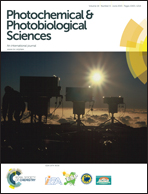Stepwise photoconversion of an artificial light-harvesting array built from extended BODIPY units†
Abstract
A molecular dyad, comprising two disparate extended boron dipyrromethene (BODIPY) units, has been identified as a potential component of artificial light-harvesting arrays. Highly efficient, intramolecular electronic energy transfer takes place under illumination but there is some competition from light-induced electron transfer along the molecular axis. The primary energy acceptor has a somewhat shortened excited-state lifetime and reduced emission quantum yield due to charge transfer from a terminal amine residue, the latter being required for the molecular system to operate in organic solar cells. Under continuous illumination with simulated solar light, the dyad undergoes very slow decomposition. In a protic solvent, both BODIPY units degrade at the same rate via an autocatalytic process. The products, one of which is a protonated analogue of the donor, degrade further by independent routes. In aprotic solvents or thin plastic films, the acceptor BODIPY dye absorbing at lowest energy undergoes photochemical degradation as above but the donor is much more stable under these conditions. At each stage of degradation, the molecule retains the ability to sensitize an amorphous silicon solar cell and the overall turnover number with respect to absorbed photons exceeds 10 million. The optical properties of the target compound nicely complement those of the solar cell and sensitization helps to avoid Staebler–Wronski photo-degradation.


 Please wait while we load your content...
Please wait while we load your content...